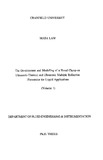JavaScript is disabled for your browser. Some features of this site may not work without it.
| dc.contributor.advisor | Sanderson, M. L. | |
| dc.contributor.advisor | Guilbert, A. R. | |
| dc.contributor.advisor | Ward, G. | |
| dc.contributor.author | Law, Masa | |
| dc.date.accessioned | 2010-10-04T15:20:52Z | |
| dc.date.available | 2010-10-04T15:20:52Z | |
| dc.date.issued | 1994-02 | |
| dc.identifier.uri | http://dspace.lib.cranfield.ac.uk/handle/1826/4596 | |
| dc.description.abstract | The development of a novel combined "ultrasonic/thermal" with "ultrasonic multiple reflections" clamp-on meter for measuring a wide flowrate range of clean liquids in small diameter pipes is presented. Current existing flowmeters based on ultrasound cannot measure very low flowrates for single phase liquids. The ultrasonic/thermal technique can measure single phase flows in the range 0 to 0.6 m s' in pipes with diameters as small as 15 mm. It can also detect and measure reverse flows. The minimum flowrate for the ultrasonic multiple reflection technique is about 0.55 m s', and theoretically, the measurement accuracy increases with increased flow velocity. The ultrasonic/thermal technique is based on a heating element and transducer pair(s) which can be clamped to the outside of a pipe. With the heaters switched on, the changes in the temperature of the pipe and the liquid inside it result in changes in transit time. The flowrate can be therefore estimated by either the transit time difference across the pipe at the two symmetric locations with respect to the heater centre, or at one location with a heater off/on comparison. The latter approach was felt to be the promising for low flowrate measurements and therefore selected for the numerical and the experimental investigations. The multiple reflection technique was developed based on the conventional transit time flowmeter. This technique extended the measuring range of the flowmeter and provided cross calibration for the ultrasonic/thermal technique. A computer model was developed for the ultrasonic multiple reflection technique. However, there was insufficient experimental data to confirm the computer prediction. Results from computational fluid dynamics (CFD) analysis of the meter are presented. For vertical pipes an axisymmetric model was used, but the presence of buoyancy forces required the use of a 3-D model for horizontal pipes. Temperature and velocity distributions and ultrasonic transit times have been computed and are presented. In order to overcome the problem of mode conversion and refraction at the pipe wall/transducer mounting interface, novel transducers and mounting blocks are presented. A prototype heater and ultrasonic transducer system together with electronics for signal generation and transit time measurement have been designed and constructed. A hydraulic system has also been designed and constructed for testing the developed clamp-on flowmeter. Experimental results from this apparatus are presented and compared with the CFD predictions, and a technique for compensating for variations in inlet temperature is described. The full scale difference between the computed values and experimental results of the meter for low flowrate measurement was about 3.5%. | en_UK |
| dc.language.iso | en | en_UK |
| dc.publisher | Cranfield University | en_UK |
| dc.title | The Development and Modelling of a Novel Clamp-on Ultrasonic-Thermal and Ultrasonic Multiple Reflection Flowmeter for Liquid Applications. | en_UK |
| dc.type | Thesis or dissertation | en_UK |
| dc.type.qualificationlevel | Doctoral | en_UK |
| dc.type.qualificationname | PhD | en_UK |
